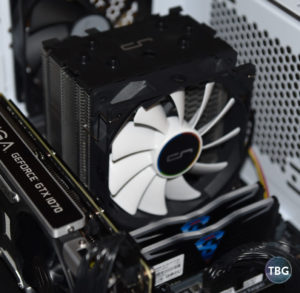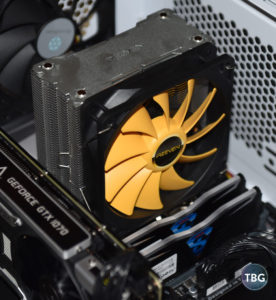The 120mm CPU Cooler Shootout: Best on a Budget
Introduction
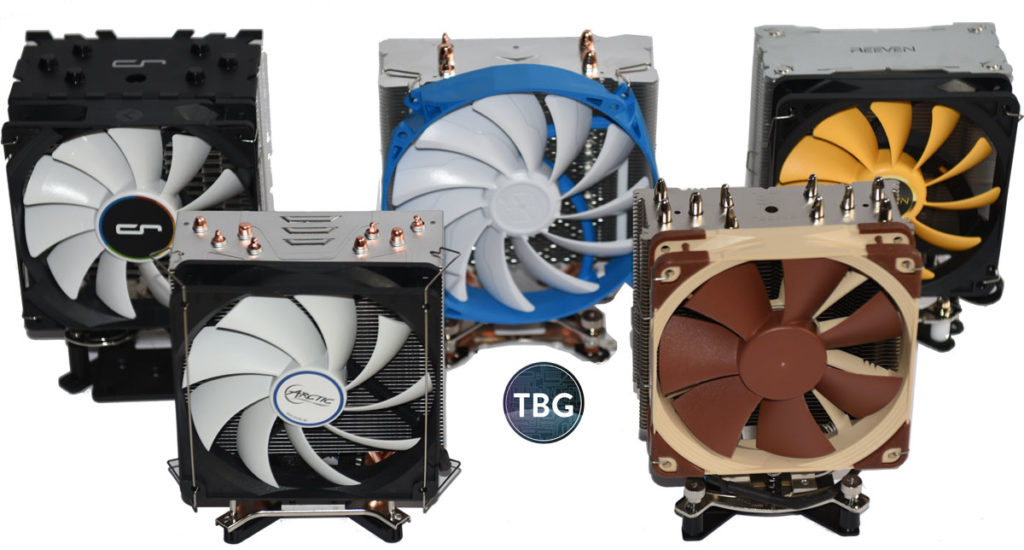 For the past few years, The Tech Buyer’s Guru has been on a quest to find the very best CPU coolers on the market at every price point, and in every form factor. In mid-2015, we published a comprehensive guide to CPU coolers, benchmarking six coolers featuring vastly different designs, from a low-profile 92mm model to a dual 120mm liquid cooler, using Intel’s Core i7-4770K as the test platform. That overview set the stage for many articles to follow. First we conducted a comprehensive shootout among high-end coolers, starting at $50 and going up over $100, using the hexa-core Intel Core i7-5820K as the test platform. And then in mid-2016, we published a review of five 140mm CPU coolers using the Core i7-6700K as the test CPU. Finally, in late-2016, we published a shootout comparing a number of low-profile coolers, using the Core i5-6600K and an ITX motherboard as the test platform. That means we have just one major category of coolers to cover, mainstream 120mm coolers, and that’s what you’re going to read about today.
For the past few years, The Tech Buyer’s Guru has been on a quest to find the very best CPU coolers on the market at every price point, and in every form factor. In mid-2015, we published a comprehensive guide to CPU coolers, benchmarking six coolers featuring vastly different designs, from a low-profile 92mm model to a dual 120mm liquid cooler, using Intel’s Core i7-4770K as the test platform. That overview set the stage for many articles to follow. First we conducted a comprehensive shootout among high-end coolers, starting at $50 and going up over $100, using the hexa-core Intel Core i7-5820K as the test platform. And then in mid-2016, we published a review of five 140mm CPU coolers using the Core i7-6700K as the test CPU. Finally, in late-2016, we published a shootout comparing a number of low-profile coolers, using the Core i5-6600K and an ITX motherboard as the test platform. That means we have just one major category of coolers to cover, mainstream 120mm coolers, and that’s what you’re going to read about today.
Now, we want to make clear that we approach CPU cooler reviews very differently than just about every other PC review site out there. First of all, we no longer do one-off reviews, because we just don’t find them that interesting or informative to read (or to write). Second, we don’t use the same old platform month after month, year after year, because you know what… cooling a Core 2 Quad or a Core i7-920 is a whole lot different than cooling a Core i7-7700K. And while this comes at the expense of cross-article comparisons, we make up for that by always giving you a look at a wide array of coolers all at once. That means they’re all tested on the same platform, under the same conditions, and in the same timeframe, so we can honestly compare not just the numbers, but the user experience.
We’ve built up enough trust among CPU cooler manufacturers that most of them are more than eager to provide test samples, and we’re more than eager to consider their latest offerings. Here are the five coolers we’re testing, along with their retail prices as of our publication date:
- Arctic Freezer i32 – $30 (special thanks to Arctic for providing this review sample)
- Cryorig H7 – $35 (special thanks to Cryorig for providing this review sample)
- SilverStone AR07 – $28 (special thanks to SilverStone for providing this review sample)
- Noctua NH-U12S – $58 (special thanks to Noctua for providing this review sample)
- Reeven Hans – $29 (special thanks to Reeven for providing this review sample)

The names Arctic and Noctua should be well-known to just about anyone who’s followed the PC industry over the past decade. These two European-based companies (Arctic is Swiss, Noctua is Austrian) have developed a reputation for both performance and reliability. Cryorig and Reeven are newcomers to the field, and both being based in Taiwan have access to the latest manufacturing tech (coolers and fans are actually manufactured in Taiwan).
Finally, we have SilverStone, which is the only company represented that’s really a full-range manufacturer. SilverStone makes cases, power supplies, and a wide range of PC accessories, and our guess is that it has the biggest budget of any of these companies. That being said, it oddly didn’t have a new 120mm cooler to submit for this shootout. Keen observers will notice that the AR07 sample we have is actually a 140mm cooler. So why did we include it in a “120mm CPU Cooler Shootout”? We decided to consider it because its size and price actually puts it in direct competition with 120mm coolers, making for an interesting comparison. We also tested it in our previous 140mm Cooler Shootout, which allows some degree of cross-comparison for shoppers deciding between these two classes of coolers. Note that it just barely squeezed into our mid-range case, and is likely the only 140mm-based cooler on the market that could do so, given that it comes in under 160mm tall. For a lot of PC builders, 140mm-class coolers just haven’t been an option previously, because every other model is over 160mm tall.
Now, we know what some of you are thinking:
But where’s the Cooler Master Hyper 212 Evo? Don’t you know that’s the best cooler out there?!?
Yeah, we anticipated that. Well, here’s the deal. We’ve been testing different variants of the Hyper 212 design since it was released over a decade ago, and we actually asked our contact at Cooler Master for a sample of the latest iteration, the Hyper 212X. As it turns out, Cooler Master was the only manufacturer we contacted to decline to participate in this roundup. Given that fact, we’ll go ahead and speculate as to the reason: the Hyper 212 just isn’t very good. Yes, the Hyper 212 Evo is, and has been, the top-selling CPU cooler for over five years, but that does not mean it’s actually worth buying. And this is an important point, and one of the reasons we founded this site. A lot of products end up being recommended again and again due to word of mouth or simply because they appear on “top seller” lists. We, however, aim to give our readers facts, not feelings. While some may “feel” the Hyper 212 Evo is the benchmark among 120mm coolers, the fact is it’s simply one of the cheapest coolers on the market, nothing more. Based on our previous testing (and the testing of a number of other review sites), we know it’s actually one of the worst-performing 120mm coolers currently on the market, and that’s because in the face of brisk sales, Cooler Master has chosen not to innovate. When it was released in 2009, the Hyper 212 Plus was actually a pretty decent pick. In today’s world, we don’t think anyone should bother with any of the 212 models, not only due to their tepid performance, but also because they’re a pain to install, offer poor RAM compatibility, and have loud, low-quality fans.
All right, with that all clear, we can return to our regularly-scheduled program!
Test Method
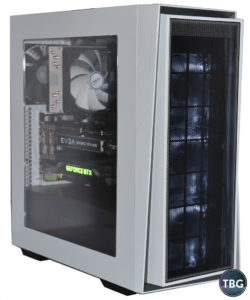 As always, we benchmark coolers on the latest test platforms, meaning you know how these coolers will work on gear you’re buying today. Here’s the system we used to rate our contenders:
As always, we benchmark coolers on the latest test platforms, meaning you know how these coolers will work on gear you’re buying today. Here’s the system we used to rate our contenders:
- CPU: Intel Core i7-7700K
- Motherboard: Gigabyte GA-Z270X-UD3
- Video Card: EVGA GeForce GTX 1070 SC 8GB
- SSD #1: Samsung 850 Evo 500GB M.2
- SSD #2: Crucial MX300 1TB 2.5″
- RAM: GeIL 2x8GB Super Luce DDR4-3000
- Case: SilverStone RL06-Pro
- Power Supply: SilverStone Strider 850W Platinum
- Operating System: Windows 10 Flash Drive
Note that we chose to provide complete benchmarks of our CPU mostly in a stock state, with one benchmark run in an overclocked state. In the past, we’ve done the opposite, but as you’ll see, what Intel has done with the Core i7-7700K makes cooling it a wholly-different story than cooling the previous generation of chips. Also note that while our test system, pictured above, is equipped with dual video cards, we removed the lower card (a GTX 1070 Founders Edition), because we test CPU coolers in a silent test system – all fans are off during testing. The GTX 1070 Founders Edition does not shut its fans off at idle, so we pulled it from the system for testing. Likewise, we disconnected all case fans, and our 850 Platinum-rated power supply didn’t come close to needing to ramp up its fan during testing. The SilverStone RL06-Pro case we used for this test provides tremendous airflow, allowing the CPU coolers to breathe even though the case fans are off. It’s a compact case, however, and officially only has clearance for coolers up to 158mm tall. Our 159mm-tall SilverStone AR07, the largest cooler we tested, fit with about 1 millimeter to spare,
In terms of fan settings, most reviews simply run fans at maximum, show the results, and on a separate page might provide noise data. Frankly, this just isn’t good enough. Performance data divorced from noise data is meaningless, and it has encouraged manufacturers to “juice” the benchmarks by shipping coolers with ever-faster fans. Fast fans may increase overall performance, but they come with diminishing returns, and more importantly, deliver a serious penalty in terms of noise. Therefore we ran our coolers through two separate sets of tests. First, we ran all of our coolers with their fans set to 1000RPM, which we view as a reasonable speed for extended use. In so doing, we are putting the coolers on equal footing (assuming their fans are generally up to the task), and truly shedding light on the effectiveness of their thermodynamic design. Second, we recorded data using motherboard PWM fan controls, which is the default for most systems, and therefore likely to be the setting most commonly used by PC builders. Our custom fan profile starts ramping up at higher temperatures than standard PWM profiles, a subject we’ll touch upon later in this article.
And what about the actual tests we performed? We conducted all analysis with an ambient temperature of 68°F. We use three different test scenarios to benchmark our coolers. First is idle at the desktop, where we report the minimum over a five-minute span (minor OS operations can spike temperatures momentarily, but these spikes can safely be ignored). Second is load in the CPU-z built-in benchmark, where we report the maximum at the point where thermal equilibrium is achieved. The third is Intel Burn Test, where we report the maximum after a 10-loop run. As you’ll see, each of the tests we ran demonstrates a distinct facet of cooler performance, allowing us (and you) to gain a better understanding not just of how these coolers perform, but why they perform the way they do. Temperature data are collected using the wonderful app HWMonitor.
All right, with that introduction out of the way, it’s time to get into the nitty-gritty of our results, starting with a review of installation!
Installation
To further assist readers who’d like to use any of the other coolers we tested, we’re providing a few installation notes for each model below.
Arctic Freezer i32
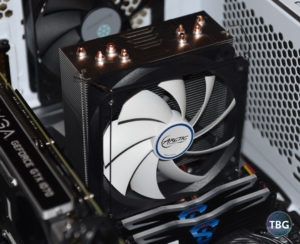 The i32 is relatively easy to install, with a user-friendly back bracket that self-adheres to the motherboard so you can focus on affixing the heatsink to the front. This cooler is quite compact, but like most of the models in this roundup, you must attach the fan after attaching the heatsink, and this can be a bit tricky to do in a cramped case. The fan clips are functional, but resemble overgrown paper clips, and feel a little cheap in practice.
The i32 is relatively easy to install, with a user-friendly back bracket that self-adheres to the motherboard so you can focus on affixing the heatsink to the front. This cooler is quite compact, but like most of the models in this roundup, you must attach the fan after attaching the heatsink, and this can be a bit tricky to do in a cramped case. The fan clips are functional, but resemble overgrown paper clips, and feel a little cheap in practice.
Arctic’s i32 cooler is the only model currently on the market designed with a zero-RPM fan. While any fan can of course be turned off if power is cut to it, this fan actually interprets a low-RPM PWM signal as indicating an idle request, and the fan shuts down without stalling or stuttering. Now, truth be told, we found that this feature caused more problems than it solved, in part because not all motherboards we’ve tested it with (we’ve installed it on three) work correctly with it. Some of them wouldn’t put the fan “to sleep”, and in the case of the Gigabyte board we used for this test, the minimum RPM level was just too high, meaning the fan would go from off to medium-high over and over again, which is worse than just maintaining a constant low-RPM level in terms of both noise and cooling. Later on this page you’ll see our RPM chart, which will illustrate this problem vividly.
Cryorig H7
If you want to see true innovation in the cooler industry, you ought to pay close attention to Cryorig. The H7 ships fully assembled, and amazingly, you don’t need to remove the fan to attach the heatsink to the motherboard. That’s because unlike any other model, the screws are affixed through the back of the motherboard.
The rear bracket is made of plastic, which is a bit unusual, and in fact part of the tension applied to the CPU comes through the bracket itself bending, sort of like a diving board. We assume Cryorig’s engineers have stress-tested this plastic for long-term durability under constant strain. Note that the H7 only employs three heatpipes, which we view as another indication of its budget origins.
Interestingly, although the H7 has by far the deepest heatsink from front to back, it also has among the best motherboard and case clearance because the heatpipes are offset down and back. That means it sits far from the RAM slots, and we’ve found that this in turn makes it one of the only viable heatsinks for use on ITX motherboards. It’s also great for mid-sized ATX and mATX cases, due to being just 145mm tall. Proof is in the performance, but first impressions suggest this is a class act.
Noctua NH-U12S
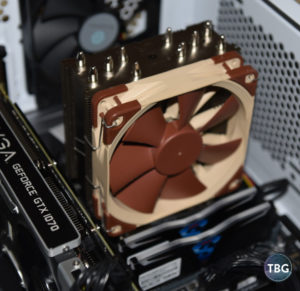 Noctua originated the concept of a truly premium cooler, and the NH-U12S carries on in that tradition. Everything from the packaging to the manual to the accessory bundle is first rate. You get spring clips and rubber anti-vibration pads not just for the included NF-F12 fan, but for a second fan should you wish to mount one. You also get a low-noise adapter, which cuts voltage to the fan for applications where you don’t need its maximum capacity for cooling, along with a tube of Noctua’s unrivaled NT-H1 thermal paste.
Noctua originated the concept of a truly premium cooler, and the NH-U12S carries on in that tradition. Everything from the packaging to the manual to the accessory bundle is first rate. You get spring clips and rubber anti-vibration pads not just for the included NF-F12 fan, but for a second fan should you wish to mount one. You also get a low-noise adapter, which cuts voltage to the fan for applications where you don’t need its maximum capacity for cooling, along with a tube of Noctua’s unrivaled NT-H1 thermal paste.
For the longest time, Noctua’s SecuFirm2 mounting system has been the gold-standard for ease-of-use. Indeed, it’s still among the very best, but we’d say that Cryorig’s pre-assembled mount is even more impressive, and takes slightly less time to install. Still, unlike Reeven, Arctic, and SilverStone, the Noctua bracket is fully assembled with fixed posts, meaning you don’t have to hold the posts from the back side of the motherboard while affixing the mount on the front. Furthermore, the nuts used to secure that mount are topped with Philips-type screw notches, make them very easy to affix. Overall, Noctua is still at the top in terms of the user experience, but it also comes at an ultra-premium price: the NH-U12S sells for $58, over $20 more than the second most expensive cooler in this test.
Reeven Hans
The Hans uses a modified version of Noctua’s proven bracket design, but unfortunately adds a few extra parts, making things more complicated. To bolt down the heatsink mount to the bracket, Reeven went with an odd choice: standard nuts, which must be attached with the included mini-ratchet. Why it didn’t use nuts topped with screwdriver slots is beyond us, as that’s a lot easier to affix inside a case. Another issue was that the fan clips were too thick to easily attach to the heatsink, which has fins so closely spaced that the clip wires could barely be inserted between them. It seems Reeven may need to slightly redesign the clips to make them easier to use.
By the way, special props to Reeven for the great style of its ultra-modern cooler. Reeven flattens the tips of its four heatpipes at the top of the cooler, allowing it to affix a cool brushed metal nameplate. This really cleans up the look of the cooler for those who like to show off their build’s interior. For better or for worse, however, Reeven has settled on a yellow-on-black color scheme for its fans, which some users may really like, although its likely to clash with the color scheme of other components.
SilverStone AR07
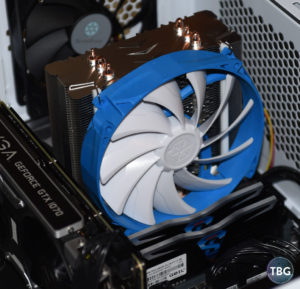 We’ve tested this cooler several times, and just can’t understand why SilverStone has made the the AR07’s bracket so hard to use. We’ve had multiple readers complain to us after buying this or similar SilverStone coolers that it won’t fit on Intel’s 1151 Socket. Well, in truth it does, but it works in a very obtuse way. You have to use a different hole on each of the four corners of the bracket, which you can only determine through trial-and-error. This needs fixing, SilverStone! Other odd elements of the mount design include nuts for the bracket that can only be hand-tightened, which begs the question of whether enough mounting pressure can be achieved, plus fan clips that have no pull tabs, making them incredibly difficult to pull over the notches on the heatsink. In fact, we practically broke a nail trying to get them into place. Overall, the AR07 simply needs a revamp – it’s by far the hardest cooler to install among the five we tested, made harder by its wide stance, which puts it very close to the video card and the top of the case.
We’ve tested this cooler several times, and just can’t understand why SilverStone has made the the AR07’s bracket so hard to use. We’ve had multiple readers complain to us after buying this or similar SilverStone coolers that it won’t fit on Intel’s 1151 Socket. Well, in truth it does, but it works in a very obtuse way. You have to use a different hole on each of the four corners of the bracket, which you can only determine through trial-and-error. This needs fixing, SilverStone! Other odd elements of the mount design include nuts for the bracket that can only be hand-tightened, which begs the question of whether enough mounting pressure can be achieved, plus fan clips that have no pull tabs, making them incredibly difficult to pull over the notches on the heatsink. In fact, we practically broke a nail trying to get them into place. Overall, the AR07 simply needs a revamp – it’s by far the hardest cooler to install among the five we tested, made harder by its wide stance, which puts it very close to the video card and the top of the case.
Summary Notes
The photo here shows the relative sizes of each of the coolers. You have the Arctic Freezer i32 at top-left, Cryorig’s H7 at top-right, Noctua’s NH-U12S in the middle, the Reeven Hans at lower-left, and the SilverStone AR07 at lower-right.
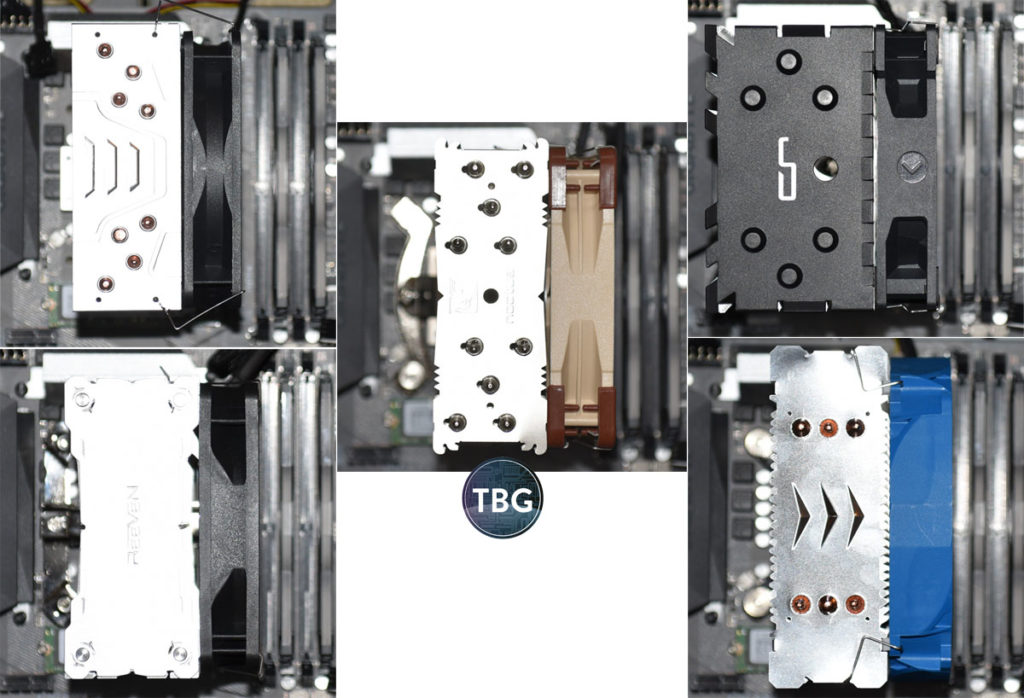
Being the only 140mm cooler in the roundup, the AR07 is by far the widest, and is the only one to block the first PCIe slot. Luckily, most motherboard manufacturers have adjusted to a new reality where 140mm coolers are commonplace, and have moved the first full-size PCIe x16 slot to the second position. That means a PCIe x1 slot is in the first position, which is of significantly less concern for enthusiasts. Among the 120mm coolers, the Arctic is 150mm tall, the Noctua is 158mm tall, and the Reeven is 155mm tall, and their depths are all quite similar. Only the Cryorig really breaks the mold: it’s much deeper, but also much shorter, at 145mm, thanks to the significant bend in its heatpipes that lets it sit back and low on the board. Also of note: the Cryorig, Noctua, and Reeven all have heatsinks that weigh around 580g, while the Arctic and SilverStone heatsinks are both about 100g less. Does greater mass inherently lead to better performance? We’ll soon see!
As we noted on the previous page, since our last cooler test, we put together a new test system based on Intel’s Core i7-7700K quad-core CPU and Gigabyte’s GA-Z270X-UD3 motherboard. These components both have a role in determining outcomes for our coolers. First, it’s important to realize that the 7700K is in reality a factory-overclocked 6700K. While Intel can spin the 7700K release however it wants, we buy our CPU samples at retail and test them against previous retail CPUs, so we’re going to tell you how it is. The 7700K at stock settings draws as much power, and runs as hot, as a 6700K overclocked to the same levels. There’s no magic here folks. And what that means is that although Intel has found a way to increase maximum overclocking headroom on the 7700K (yes, 5GHz is quite achievable, whereas it wasn’t on the 6700K), this requires as much voltage as you might think it would, i.e., a lot. And that means the processor is really darn hot at 5GHz. As for the motherboard, this one has more sophisticated fan controls than previous models, including a very potent Windows suite called Gigabyte System Information Viewer (SIV), which we used both to determine fan characteristics and develop a custom fan profile for testing. We’ve charted our findings in the table below:
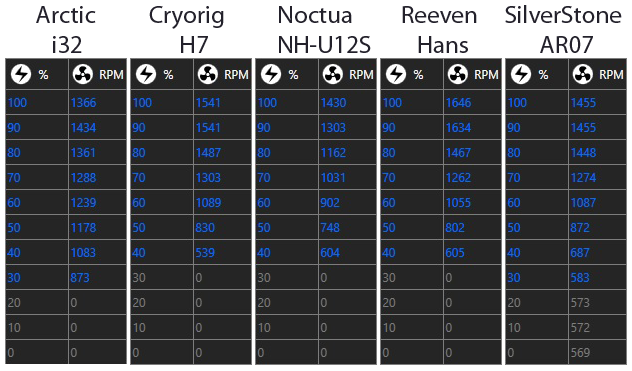
A few things to note here: the minimum RPM levels weren’t entirely accurate, as each of these fans was capable of operating at slightly lower RPMs before stalling, but the maximums, on the other hand, were quite accurate. So you’ll see that Arctic is very conservative with its fan, befitting a “silent cooler,” while Cryorig and especially Reeven really let their fans run wild. We’ll see what that means for both performance and noise in our full-load tests.
Performance (Fixed 1000 RPM)
We begin our benchmarks with the fans on each cooler fixed at 1000RPM. Note that due to a protective feature in Gigabyte’s fan-control software, the system overrides the fixed 1000RPM when temperatures exceed 70 °C. That means we’ll just be testing temperatures at idle and in the CPU-z stress test, skipping Intel Burn Test here, as well as all overclocked tests.
Here’s are the idle numbers:
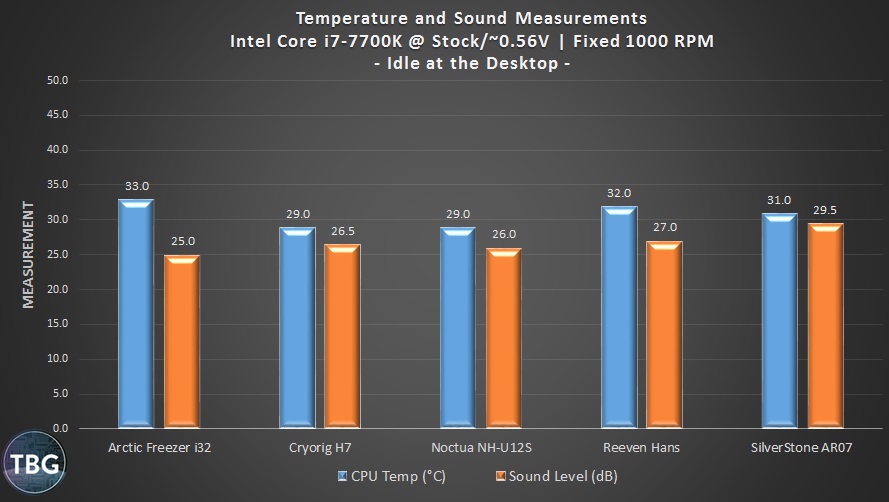
A few really important things to see here. First, bigger fans tend to make more noise than small fans at the same RPM, that’s just a fact of life (and physics), so the AR07 is at a disadvantage here. Truth be told, however, SilverStone just doesn’t make particularly quiet fans. We’ve tested a lot of them, and they’re all louder than average. On the other end of the spectrum, Noctua’s NF-F12 PWM fan is simply astounding. It provides the second-quietest performance and is tied for the best results. Note that while the Arctic Freezer’s fan is even quieter, the heatsink lets it down, leading to the highest temperatures in this test. And what of the newcomers Cryorig and Reeven? Well, Cryorig knocks one out of the park, virtually matching Noctua’s performance, which is amazing given that the entire H7 package costs just $15 more than Noctua’s fan. Reeven does pretty well here too, at least with regard to noise. We were surprised, however, that its heavy heatsink didn’t produce an idle temperature result closer to Cryorig and Noctua.
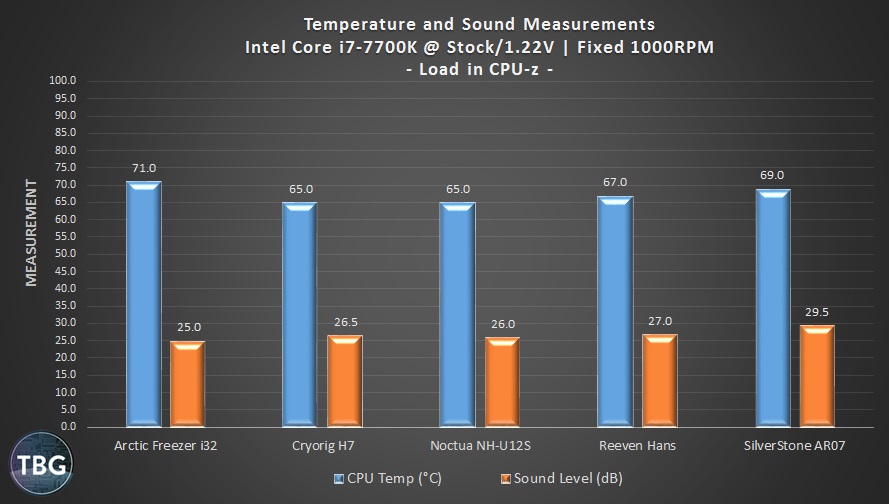
This is the test that most closely approximate the load presented by typical applications. For example, we’ve found these results to be nearly identical to what you’d see in a multi-player match of the game Battlefield 1. The truth is that these temperatures are all a bit higher than we would have liked, and that’s because the Core i7-7700K is a pre-overclocked, pre-overvolted processor. Thanks a lot, Intel! Arctic again wins with regard to noise and loses badly with regard to temperature, while the dualing Cyrorig and Noctua coolers again end up at the top. The Reeven Hans, which was the cheapest cooler when we published this article, provides very impressive performance for the price, and is a viable alternative to the H7 as long as it’s less expensive.
Creating a Custom Profile
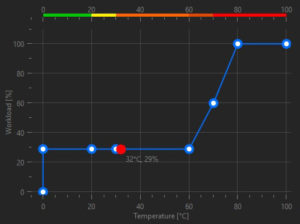
As we discussed earlier, one common test you’ll see in tech publications is benchmarks using the maximum fan RPM, which really isn’t all that informative. Manufacturers have caught on to this testing, and they routinely equip their coolers with fans that run very fast and very loud. Users really shouldn’t be running their fans at maximum RPM, and that’s not how they’ll work out of the box anyway. All modern motherboards apply some form of PWM control to CPU fans.
That being said, the default controls tend to be less than ideal, as they will typically start ramping the fan speed up linearly from 40% to 100% starting at 30 °C, which is below what most CPUs will idle at. In other words, you will hear the fan speeding up and slowing down constantly, even when you’re just surfing the Web. Therefore, we created our own custom PWM fan profile for purposes of this test, which you can see here. In essence, the fans are kept at their minimum level until 60 °C, at which point they begin to ramp up nearly linearly until they hit maximum at 80 °C. As you’ll see in our next tests, we have different scenarios that place the fans at various points on this curve, allowing you to get a better sense of how they operate under a range of real-world conditions.
Performance (PWM-Controlled)
First up, idle numbers.
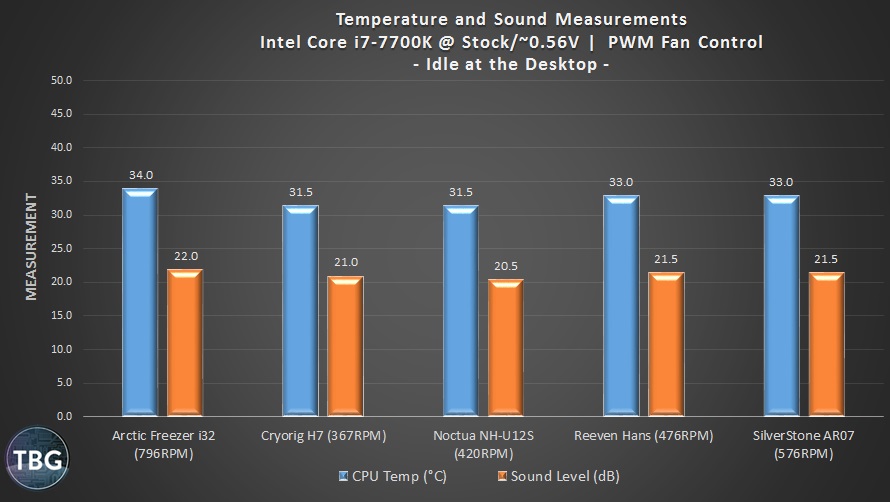
Bliss, bliss, bliss. That’s what you’ll achieve when you’re running the Noctua NH-U12S. The fan is simply sublime, with a wide operating range, good airflow, and exceptional noise levels. The Cryorig nearly matches it again, however, thanks to an even wider RPM range that lets it dip below 400RPM without stalling. Note that because our motherboard didn’t quite know what to do with the Arctic fan, it ended up not dropping to zero RPM, defaulting to a high 896RPM instead. The truth is, however, that it really needed an active fan at idle, because temperatures would have crept too high without the fan running.
Below are the results in our “real world” load test, CPU-z.
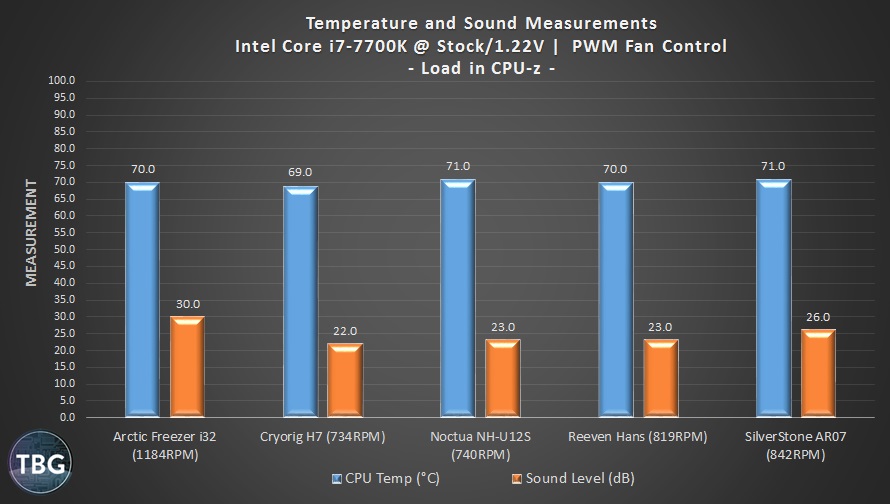
What do we have here? Is that Cryorig’s cooler sneaking past the Noctua with regard to both temperature and noise? Impressive! Note that the fans on these two coolers were running at essentially identical speeds, which really shows that the H7 is at its sweet spot here, given that it’s typically a touch louder than the Noctua. If you look at the results across the five contenders, you might start thinking that they are surprisingly close. But take another look. The fans are running at very different RPM levels, which is why the temperatures even out, but noise levels do not. The Reeven Hans scores a nice second place win here, in fact beating out Noctua’s entry.
Finally, we illustrate cooling performance faced with the the artificially-high load generated by Intel Burn Test.
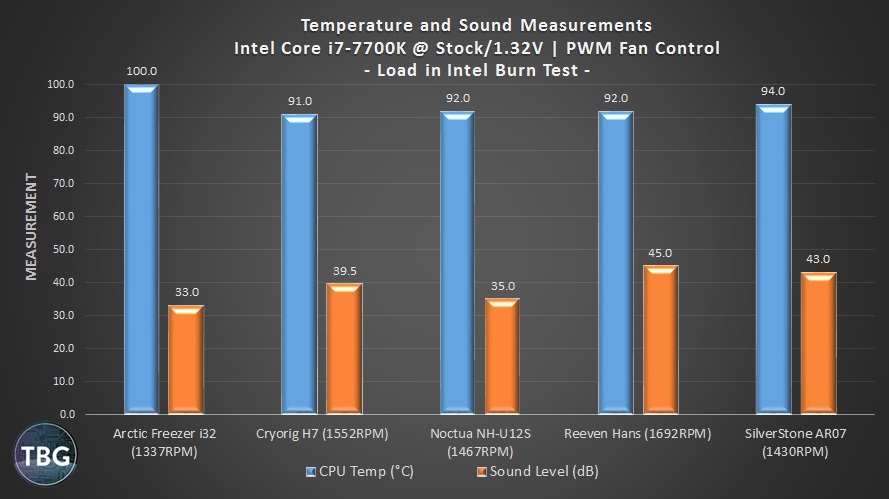
First off The Arctic Freezer i32 is simply overwhelmed by the Core i7-7700K, an overclocked processor by any other name. We consider this a “fail”, and therefore cannot recommend users choose the i32 to cool the Core i7-7700K. And while all the other coolers pass this test, the Reeven and SilverStone really lose their composure. Keep in mind that we’re seeing maximum RPM levels for all of our fans in this extreme test, and the Reeven and SilverStone fans are not in the least bit quiet when pressed to the limit. On the other hand, Noctua’s NF-F12 is basically saying “what me, worry?” The low noise level of this fan is simply astounding, and its overall result is the best in this test. Even so, Cryorig sneaks away with a technical win by achieving the lowest temperature, making a bit more noise than the Noctua in the process.
Overclocked Testing
As it turns out, a Core i7-7700K running at 5GHz using over 1.3V is not a great candidate for a low-cost cooler. We couldn’t even run our Intel Burn Test benchmark, as all our coolers immediately failed. Take note that we’re letting our fans runs with PWM control, as fixing the speed at 1000RPM wasn’t possible – our Gigabyte motherboard’s software goes into protective mode above 70 °C. And in any event, PWM is really what you should be using if you’re doing anything other than benchmarking fan performance! In the chart below, we show the highest load our coolers were able to cope with at 5GHz, the moderate CPU-z stress test:
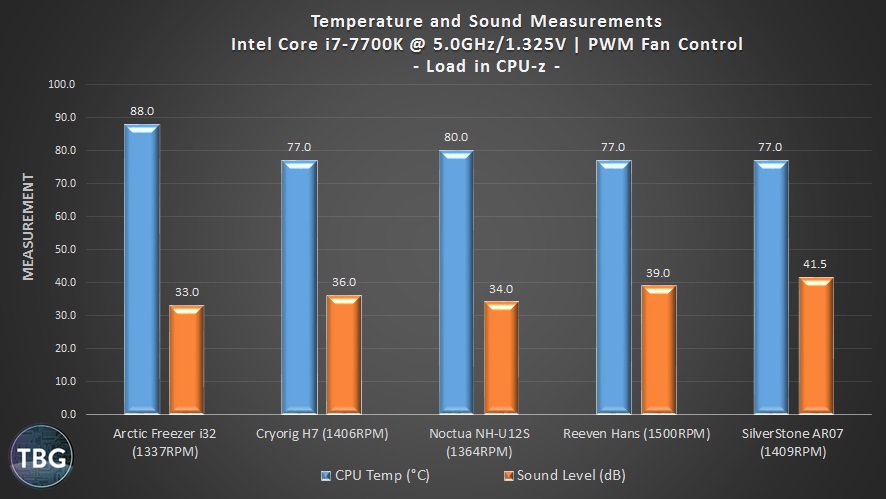
First off we can again see that the Arctic Freezer i32 is designed for lower-intensity applications, proving to be extremely quiet, but barely capable of cooling our overclocked processor in this approximation of a real-world test. We’d never run a processor for long periods of time at 88 °C. All the other coolers bunch up together in terms of temperature, with Noctua letting the processor warm up a bit more in exchange for very low noise levels, while the other coolers line up in order, all achieving the same temperature result, but going about it in very different ways. The Cryorig H7 is relatively quiet, the Reeven Hans is a bit louder that we’d like, and the SilverStone AR07 is simply too loud.
Remember, our CPU hit an instant thermal throttle in Intel Burn Test using all five coolers above, so if you’re a serious number cruncher who also likes to overclock, you may want to invest in heavy artillery when it comes to cooling.
Comparison to 140mm Heatsinks
To give readers some context, we’re republishing below a table of results from our 140mm CPU Cooler Shootout alongside a table that appeared earlier in today’s 120mm shootout. There are a few reasons this is instructive. First, one of the coolers, the SilverStone AR07, appeared in both tests, which will allow you to get rough approximations of how any of the 120mm coolers would fare in competition with 140mm models. Secondly, our overclocked Core i7-6700K ran at 4.4GHz using 1.236V, while our 7700K required around the same voltage (1.22V) to hit 4.5GHz, so this is roughly an apples-to-apples comparison. In short, the 7700K does not run appreciably cooler. You can click on the image below to get a better view:

With regard to temperature, the 140mm coolers are clearly superior (save for the AR07). But how much better are they? Running the exact same CPU-z stress test, the 120mm coolers are about 3-5 °C hotter, accounting for variations in the test conditions (ambients were the same, but the cases were different). In other words, the difference is significant, but the cost savings and ease-of-use that comes with the smaller coolers still make them compelling choices for a lot of builders. Note that sound level comparisons should not be made between these two tests, as they were significantly affected by the cases used.
Conclusion
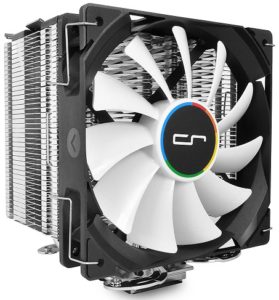
While in past roundups, we’ve selected several coolers for awards based on price, performance, style, and ease of use, this time, things are different. One cooler stood above the rest in most regards, and in our opinion is the undisputed champion. If you are buying a CPU cooler today and want the very best performance possible in a 120mm form factor, indeed the best performance you’ll find in any cooler under $40, there’s only one cooler to consider: the Cryorig H7. Everything about it screams quality, from the excellent packaging and manual, to the shockingly-simple installation process, to the ultra-quiet fan. And most importantly, it delivers performance in spades, tying our Noctua NH-U12S despite a much lower price.
As for runners up, we’ll note that Reeven Hans is an absolute bargain when discounted below $30, but at its retail price of $35, it’s not the best pick. Furthermore, availability is still quite limited, installation is a pain, and the fan tends to get a little loud. In other words, it’s the CPU cooler equivalent of a muscle car – it offers bang for the buck, but finesse isn’t exactly its forte. The Noctua NH-U12S is a wonderful cooler and is equipped with the best 120mm fan on the market. As we’ve told Noctua quite directly, however, this cooler is simply too expensive, especially given that the superior Noctua NH-U14S 140mm cooler is just a few dollars more. Noctua has informed us that there’s very little it can do to save on costs when shrinking the design down to the 120mm form factor, as both coolers are manufactured to the same high standards and have similar bills of materials. Unfortunately, that means we just can’t recommend the NH-U12S (the NH-U14S, on the other hand, is our favorite cooler at any pricepoint). With regard to the Arctic Freezer i32, it’s clearly tuned for moderate performance and ultra-quiet operation, so we recommend it for silence seekers using lower-powered systems. And the SilverStone AR07, well, luckily for SilverStone, it makes some of our very favorite cases, which we’re happy to recommend to anyone, but the AR07 is really in need of a redesign.
We hope you’ve learned a thing or two about coolers in this article – we certainly did! To see all our latest CPU Cooler recommendations at every price point and in every form factor, check out our CPU Cooler Buyer’s Guide, updated quarterly.
Update: After publication, we received the following responses from SilverStone and Noctua, which we think may be informative for our readers:
[this] shootout article is a great read! In hindsight, I probably should have sent you our AR01 instead. Didn’t realize/remember that you test the coolers in cases without case fans running. AR01’s air pressure focused fan may have performed better than AR07 in your setup.
– Tony Ou, SilverStone Technology Co., Ltd.
[In the NH-U12S] . . . price/performance isn’t something we’re overly concerned with – the goal is to deliver the best quality product, period . . . For us, soldering the heatpipes to the fins is a key aspect to true premium grade coolers as this is the only means to guarantee consistent, stable performance over many years of usuage and lots of thermal cycling . . . . [Furthermore, the] backplate serves an integral function of stiffening the entire mounting assembly and using coil springs is crucial for heavier coolers to ensure consistent pressure over multiple mounts and to avoid damage to the CPU when higher forces can act on the cooler such as during transport. Last but not least, the cooler ships with . . . our proven, time-tested 20$ NF-F12. All these aspects contribute to the fact that the NH-U12S is more expensive than other coolers, but we are confident that quality conscious buyers appreciate the extra effort we put into manufacturing our products.
– Jakob Dellinger, Noctua.at, RASCOM Computerdistribution Ges.m.b.H.

